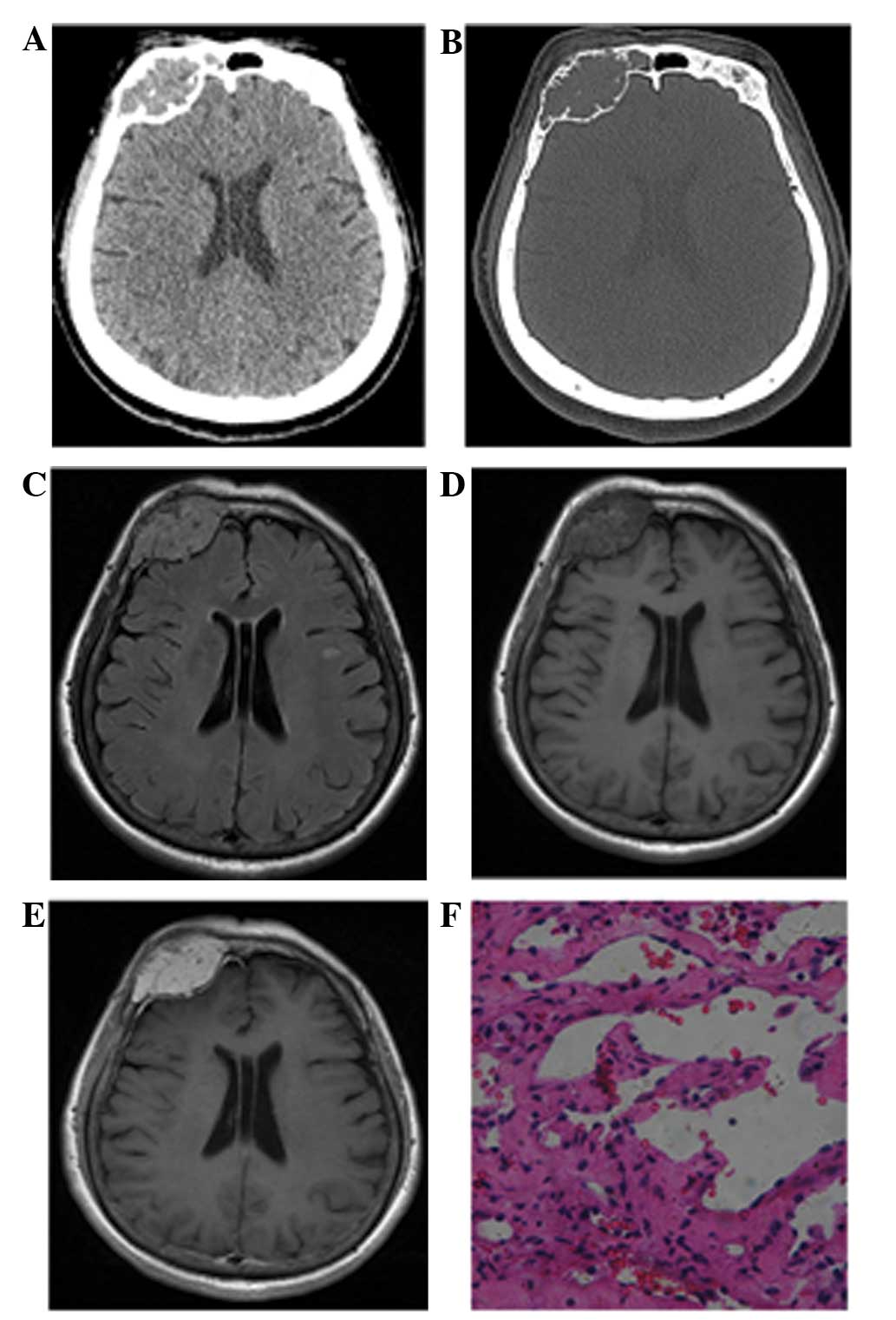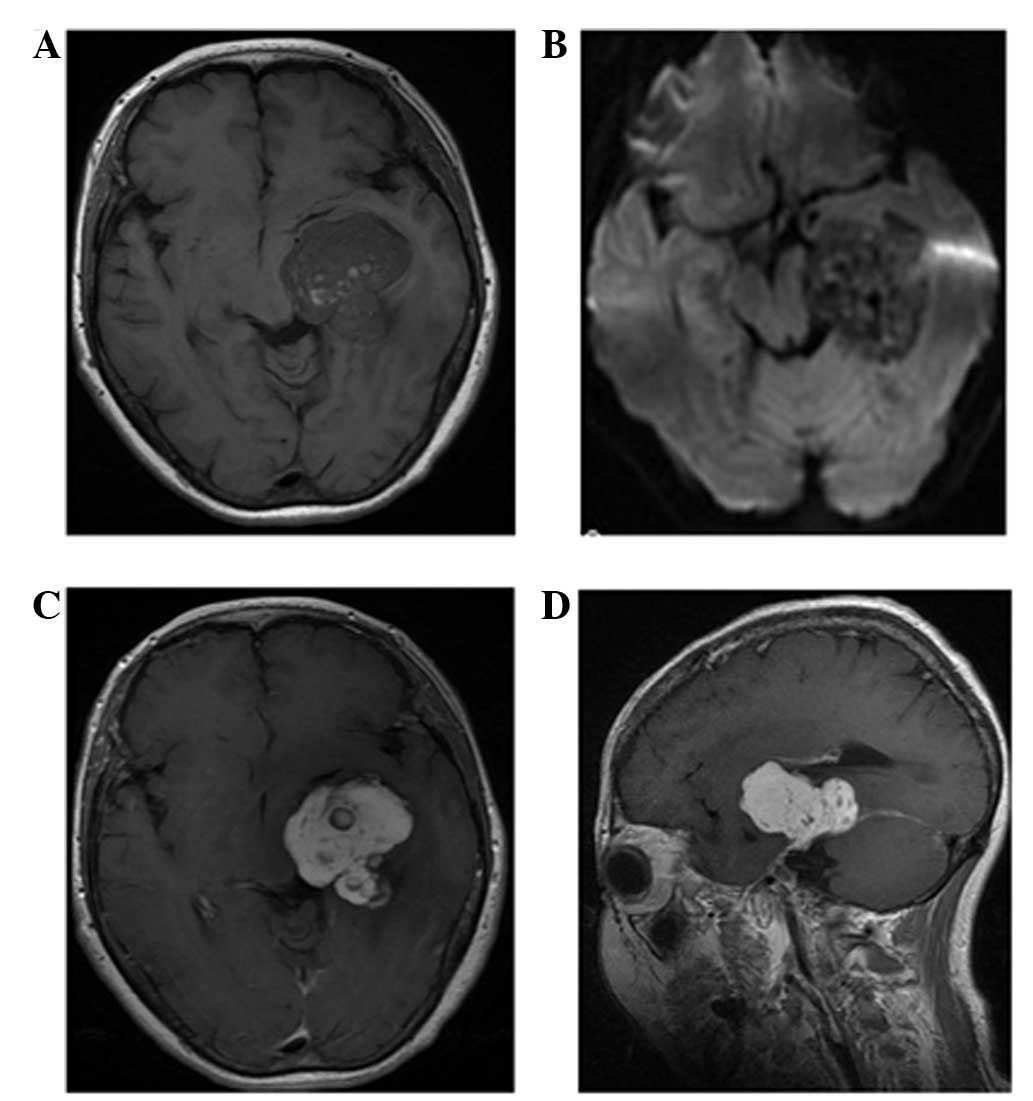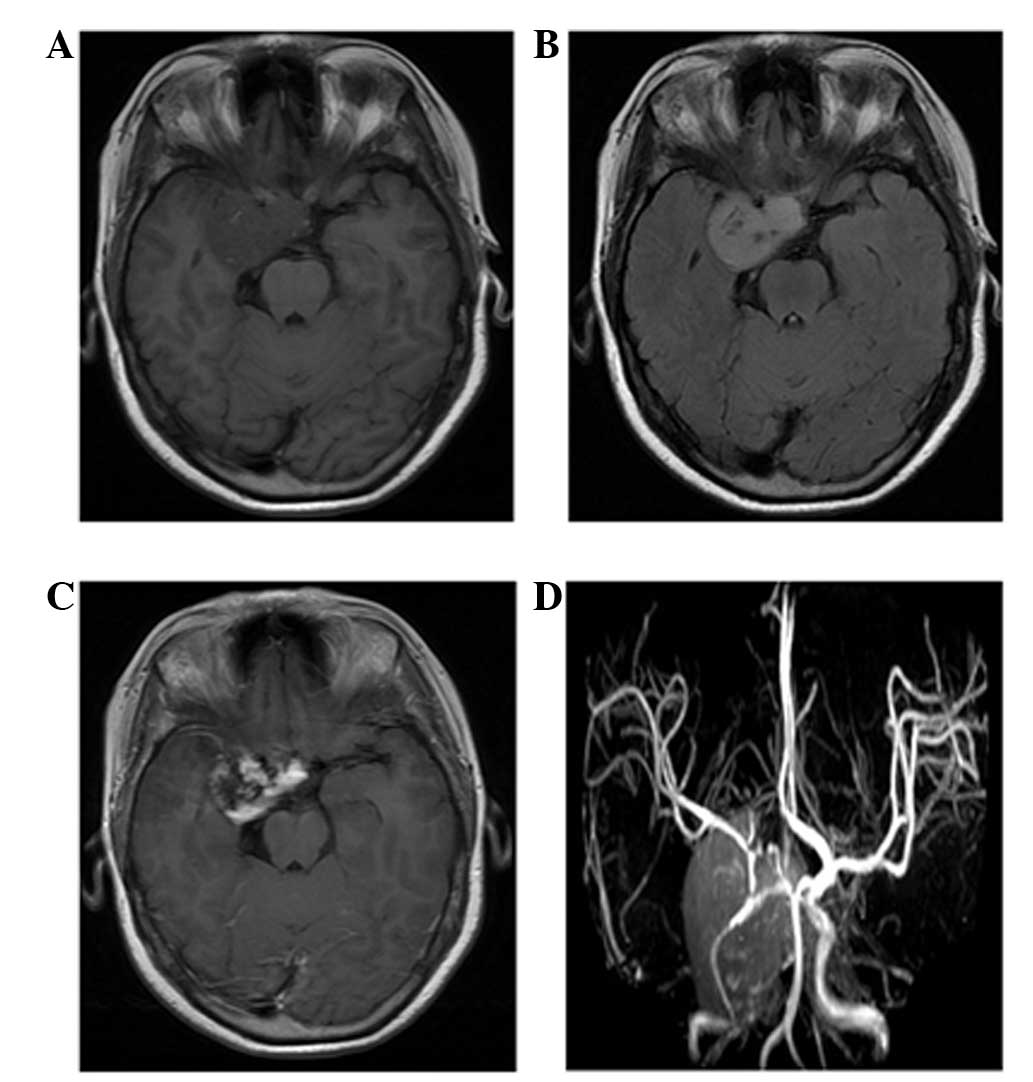|
1
|
Weiss SW and Enzinger FM: Epithelioid
hemangioendothelioma: A vascular tumor often mistaken for a
carcinoma. Cancer. 50:970–981. 1982. View Article : Google Scholar : PubMed/NCBI
|
|
2
|
Zheng J, Liu L, Wang J, Wang S, Cao Y and
Zhao J: Primary intracranial epithelioid hemangioendothelioma: A
low-proliferation tumor exhibiting clinically malignant behavior. J
Neurooncol. 110:119–127. 2012. View Article : Google Scholar : PubMed/NCBI
|
|
3
|
Baehring JM, Dickey PS and Bannykh SI:
Epithelioid hemangioendothelioma of the suprasellar area: A case
report and review of the literature. Arch Pathol Lab Med.
128:1289–1293. 2004.PubMed/NCBI
|
|
4
|
Hurley TR, Whisler WW, Clasen RA, Smith
MC, Bleck TP, Doolas A and Dampier MF: Recurrent intracranial
epithelioid hemangioendothelioma associated with multicentric
disease of liver and heart: Case report. Neurosurgery. 35:148–151.
1994. View Article : Google Scholar : PubMed/NCBI
|
|
5
|
Hamlat A, Casallo-Quilliano C, Saikali S,
Lesimple T and Brassier G: Epithelioid hemangioendothelioma of the
infundibular-hypothalamic region: Case report and literature
review. J Neurooncol. 67:361–366. 2004. View Article : Google Scholar : PubMed/NCBI
|
|
6
|
Taratuto AL, Zurbriggen G, Sevlever G and
Saccoliti M: Epithelioid hemangioendothelioma of the central
nervous system. Immunohistochemical and ultrastructural
observations of a pediatric case. Pediatr Neurosci. 14:11–14. 1988.
View Article : Google Scholar : PubMed/NCBI
|
|
7
|
Kubota T, Sato K, Takeuchi H and Handa Y:
Successful removal after radiotherapy and vascular embolization in
a huge tentorial epithelioid hemangioendothelioma: A case report. J
Neurooncol. 68:177–183. 2004. View Article : Google Scholar : PubMed/NCBI
|
|
8
|
Aditya GS, Santosh V, Yasha TC and Shankar
SK: Epithelioid and retiform hemangioendothelioma of the skull
bone-report of four cases. Indian J Pathol Microbiol. 46:645–649.
2003.PubMed/NCBI
|
|
9
|
Cho WS, Kim SK, Park SH and Cho BK:
Intracranial kaposiform hemangioendothelioma: Proposal of a new
malignant variant. J Neurosurg Pediatr. 3:147–150. 2009. View Article : Google Scholar : PubMed/NCBI
|
|
10
|
Mohan SM, Symss NP, Pande A, Chakravarthy
VM and Ramamurthi R: Intracranial epithelioid hemangioendothelioma.
Childs Nerv Syst. 24:863–868. 2008. View Article : Google Scholar : PubMed/NCBI
|
|
11
|
Palmieri G, Montella L, Martignetti A and
Bianco AR: Interferon alpha-2b at low doses as long-term
antiangiogenic treatment of a metastatic intracranial
hemangioendothelioma: A case report. Oncol Rep. 7:145–149.
2000.PubMed/NCBI
|
|
12
|
Zhang J, Wang Y and Geng D: Intracranial
epithelioid hemangioendothelioma: An unusual CTA finding in one
case. Br J Neurosurg. 24:294–295. 2010. View Article : Google Scholar : PubMed/NCBI
|
|
13
|
Chan YL, Ng HK, Poon WS and Cheung HS:
Epithelioid hemangioendothelioma of the brain: A case report.
Neuroradiology. 43:848–850. 2001. View Article : Google Scholar : PubMed/NCBI
|
|
14
|
Parajón A and Vaquero J: Meningel
intracranial epithelioid hemangioendothelioma: Case report and
literature review. J Neurooncol. 88:169–173. 2008. View Article : Google Scholar : PubMed/NCBI
|
|
15
|
Ibarra RA, Kesava P, Hallet KK and Bogaev
C: Hemangioendothelioma of the temporal bone with radiologic
findings resembling hemangioma. AJNR Am J Neuroradiol. 22:755–758.
2001.PubMed/NCBI
|
|
16
|
Kim HL, Im SA, Lim GY, Chun HJ, Lee H,
Park HJ and Byun JY: High grade hemangioendothelioma of the
temporal bone in a child: A case report. Korean J Radiol.
5:214–217. 2004. View Article : Google Scholar : PubMed/NCBI
|
|
17
|
Requena L and Kutzner H:
Hemangioendothelioma. Semin Diagn Pathol. 30:29–44. 2013.
View Article : Google Scholar : PubMed/NCBI
|
|
18
|
Mosoia L, Mabrut JY, Adham M, Boillot O,
Ducerf C, Partensky C and Baulieux J: Hepatic epithelioid
hemangioendothelioma: Long-term results of surgical management. J
Surg Oncol. 98:432–437. 2008. View Article : Google Scholar : PubMed/NCBI
|
|
19
|
Lyburn ID, Torreggiani WC, Harris AC,
Zwirewich CV, Buckley AR, Davis JE, Chung SW, Scudamore CH and Ho
SG: Hepatic epithelioid hemangioendothelioma: Sonographic, CT and
MR imaging appearances. AJR Am J Roentgenol. 180:1359–1364. 2003.
View Article : Google Scholar : PubMed/NCBI
|
|
20
|
Bourekas EC, Cohen ML, Kamen CS, Tarr RW,
Lanzieri CF and Lewin JS: Malignant hemangioendothelioma
(angiosarcoma) of the skull: Plain film, CT and MR appearance. AJNR
Am J Neuroradiol. 17:1946–1948. 1996.PubMed/NCBI
|
|
21
|
Fernandes AL, Ratilal B, Mafra M and
Magalhaes C: Aggressive intracranial and extra-cranial epithelioid
hemangioendothelioma: A case report and review of the literature.
Neuropathology. 26:201–205. 2006. View Article : Google Scholar : PubMed/NCBI
|
|
22
|
Tancredi A, Puca A and Carbone A:
Multifocal cerebral hemangio-endothelioma. Case report and review
of the literature. Acta Neurochir (Wien). 142:1157–1161. 2000.
View Article : Google Scholar : PubMed/NCBI
|
|
23
|
Hodaie M, Becker L, Teshima I and Rutka
JT: Total resection of an intracerebral hemangioendothelioma in an
infant. Case report and review of the literature. Pediatr
Neurosurg. 34:104–112. 2001. View Article : Google Scholar : PubMed/NCBI
|
|
24
|
Oliveira Rocha PC, Alcantara FP,
Souza-Vianna PE and Brito AP: Cerebral epithelioid
hemangioendothelioma with thoracic simultaneous involvement:
Advanced MRI features. Arq Neuropsiquiatr. 70:637–638. 2012.
View Article : Google Scholar : PubMed/NCBI
|
|
25
|
Wold LE, Unni KK, Beabout JW, Ivins JC,
Bruckman JE and Dahlin DC: Hemangioendothelial sarcoma of bone. Am
J Surg Pathol. 6:59–70. 1982. View Article : Google Scholar : PubMed/NCBI
|
|
26
|
Hackney JR, Palmer CA, Riley KO, Cure JK,
Fathallah-Shaykh HM and Nabors LB: Primary central nervous system
angiosarcoma: Two case reports. J Med Case Rep. 6:2512012.
View Article : Google Scholar : PubMed/NCBI
|
|
27
|
Cookston M, Cotter GW, Schlitt M and
Bastian FO: Primary angiosarcoma of the brain. South Med J.
84:517–20. 1991. View Article : Google Scholar : PubMed/NCBI
|













